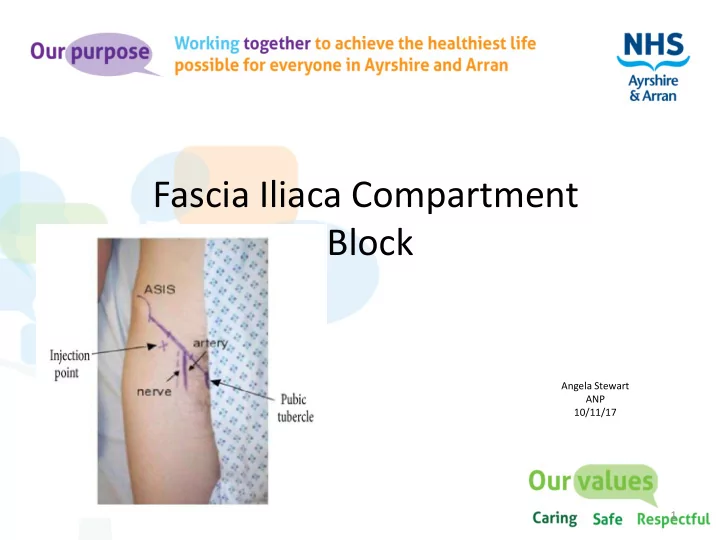

Fascia Iliaca Compartment Block Angela Stewart ANP 10/11/17 1
Driving force • Dr J. Mitchell from acute pain service Ayr hospital produced a comprehensive guideline to authorise Non-medical prescribers (NMP) education & training to perform Fascia Iliaca block (FIB) for patients with Hip Fractures 2
FICB Fascia Iliaca compartment allows accumulation of local anaesthetic of sufficient volumes to spread to at least three of the four main nerves that supply the medial, anterior and lateral thigh with one simple injection, namely the femoral, lateral femoral cutaneous & Obturator nerves . Posterior aspect of the thigh is not blocked. 3
Aims • FICB recognised as Gold Standard treatment adjunct for hip # patients to ensure effective pain management. • All Hip # patients receive FICB in Emergency department unless contraindicated & on ward particularly when operation delayed • To decrease intake of opioid consumption & reduce adverse drug effects • Reduce untreated pain. Hip # is associated with increased risks of complications such as delirium( 50% ), depression, sleep disturbance, and decubitus ulcers 4
https://learned.rocks/cooked 5
Training & Governance for ANP • Non-medical prescriber with at least one year prescribing experience • Advanced Life Support provider • Follow local FICB guideline • Complete ANP FICB competency folder • Perform 20 FICB supervised by anaesthetist • MCQ exam on Local Anaesthetic Toxicity (Last) 6
Contraindications • Patient refusal • Patients who have already had a FICB within previous 8hrs • Known sensitivity to local anaesthesia. • Anticoagulant therapy (warfarin, clopidrogel, etc.) • Clotting disorder (INR >1.5, platelet count<80) • Previous vascular surgery in affected limb • Difficulty identifying landmarks 7
Complications • Intravascular injection • Local anaesthetic toxicity - is highest in the first 15-30 minutes which makes close monitoring mandatory at this stage • Temporary or permanent nerve damage • Infection- good aseptic technique should reduce the risk of infection • Block failure - usually due to poor technique • Injury secondary to numbness/weakness of limb • Allergy to any of the preparations used - Levobupivacaine/chirocaine significantly reduces the risk of allergic reaction. (Davies 2016) 8
Prior to procedure • Obtain patient consent • Ensure IV access available • Ensure patient monitored including, ECG, NIBP, Pulse oximeter 9
Observations • Record pain & NEWS score before intervention • Following FICB repeat NEWS & pain as score per guideline (15min, 30mins, 1hour, 2hours & 4 hours following procedure) • Document and place FICB sticker in casenotes • If pain score is not improved after 30mins ensure additional analgesia is given. 10
Local Anaesthetic Toxicity • Observe for any signs of any adverse reaction Circumoral tingling, Light headedness, Visual disturbance, Seizures, Arrhythmias • Immediately stop local anaesthetic injection • Commence basic life support. • Call cardiac arrest team • Administer 100% oxygen & resuscitation • Consider Lipid rescue therapy Follow Guideline for Management of Severe Local Anaesthetic Toxicity (AAGBI guideline) 11
Local Anaesthetic Toxicity ANP,s introduced Intralipids on ward resuscitation trolley alongside AAGBI safety Guideline for administration in event of reaction. 12
Achieving FICB competencies • Mentoring education & training from Anaesthetists • Communication with theatre staff • Each morning checked trauma list to identify any new hip # patients. Discussed with trauma anaesthetist for that day if administering FICB 13
Sustaining the Future • Local agreement for ANPs to prescribe & perform FICB, reducing delays to adequate analgesia • Teaching & supporting Junior Drs & ANPs training as per A&A FICB guideline • A&A guideline recommends Drs perform 5 FICB under supervision before attempting one alone • Audit pain scores pre/post-procedure to inform of benefit/failure of FICB and +/- analgesia requirements. 14
Summary • The fascia Iliaca compartment block performed by landmark technique is inexpensive, safe and easy to perform (Davies 2016) • Delivering large volumes of low concentration local anaesthetic helps to maximize the benefits of the FICB • It provides effective pain relief whilst avoiding the side- effects of certain other forms of analgesia • Demonstrates that non-anaesthetic personnel can perform FICB successfully & provide a more prompt service 15
Conclusion • Incidence & mortality of hip fracture are stabilizing. However, irrespective of age, patients with an increasing number of comorbidities is likely to increase costs and have longer hospital length of stay (Soong, C. 2016) Every 48hr delay to theatre increases mortality at 1 month by 17% Delirium increases by 11% every 48hrs delay to theatre • All staff with various skills can contribute to Scottish Standards of care for hip # patients. Improving outcomes for patients with a hip # from ED to discharge angela.stewart@aaaht.scot.nhs.uk 16
References • Davies N,W.(2016) Fascia Iliaca Compartment Block: Landmark approach guidelines for use in the emergency department version 1.0 June 10, 2016 • Mitchell J, ( 2014) NHS AAA Fascia Iliaca block (FIB) Guideline for analgesia in patients with fractured neck of femur. • Rashid A, et al (2014) Regional Analgesia in the Emergency Department for Hip fractures: survey of current UK practice and its impact on services in a teaching hospital. Emerg Med J 2014;31:909–913 • Soong ,C.(2016) Impact of an Integrated Hip Fracture Inpatient Program on Length of Stay and Costs. J Ortho Trauma Vol 30, No 12, Dec. 2016 17
Recommend
More recommend